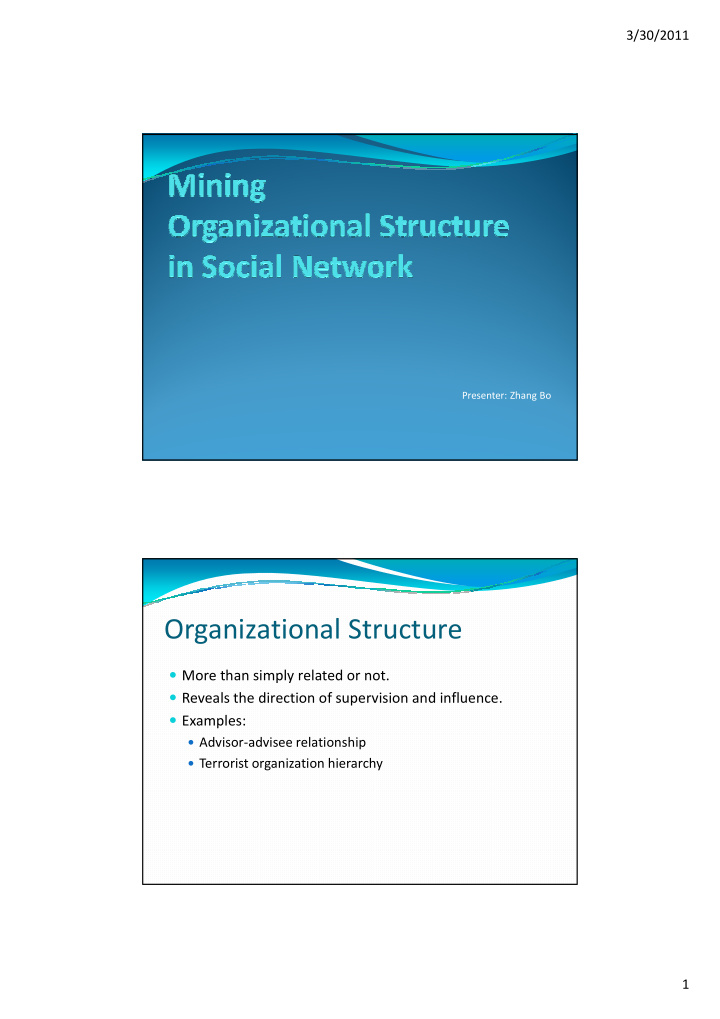



3/30/2011 Presenter: Zhang Bo Organizational Structure � More than simply related or not. � Reveals the direction of supervision and influence. � Examples: � Advisor-advisee relationship � Terrorist organization hierarchy 1
3/30/2011 Background � Community Discovery � Goal: discover related groups that have denser intra-group communication � Often reveals interesting properties. Common hobbies, social functions, etc. � Fail to show power of members and their scope of influence. � Organizational Structure Discovery � Good for finding members influential power within the structure. � Useful in many applications. Advisor-Advisee Relationship Chi Wang, Jiawei Han, Yuntao Jia, Jie Tang, Duo Zhang, Yintao Yu, and Jingyi Guo. Mining advisor-advisee relationships from research publication networks . KDD '10. � Given: publication data with co-author list � Target: Among those co-authors, find advisor-advisee pairs. � Used to find experts, or to see students of an expert. 2
3/30/2011 Example Preliminaries � a i : author i � a yi : advisor of a i � [st ij , ed ij ]: time interval that i ’s advisor is j , i.e., [2003, 2007] � [st i , ed i ]: (briefly) time interval that i is advised � py i : pub_year_vector of i , i.e., [2003, 2004, 2005] � pn i : pub_num_vector of i , i.e., [2, 3, 4] � py ij : pub_year_vector of co-author i and j ; link property � pn ij : pub_num_vector of co-author i and j ; link property � py 1 i : first component of py i 3
3/30/2011 Assumptions 1) ed j < st i < ed i � j can only advise i after j graduated. py 1 j < py 1 1) ij � Advisor j should always have a longer publication history than advisee i . More Assumptions � Kulc ij : Kulczynski ratio. Correlation of two authors’ publications � IR ij : Imbalance ratio between ( j | i ) and ( i | j ) � j is not i ’s advisor if � IR ij < 0 during the collaboration period. Advisor should have more publications than advisee � Kulc ij does not increase during the collaboration period � The collaboration period lasts for only one year � py 1 j +2 > py 1 ij 4
3/30/2011 Approach Step 1 � Step 1: preprocessing � Remove unlikely pairs; � Generate candidate graph, which is a DAG Approach Step 2 � TPFG: Time-constrained Probabilistic Factor Graph model � Let y i be advisor of a i ; we need to decide tuple ( y i , st i , ed i ) � Suppose a local feature function g( y i , st i , ed i ). Joint probability is defined as � With assumption 1 as the constraint 5
3/30/2011 Approach Step 2 � To find most possible relations, maximize the joint probability � Exhaustive search: O((CT 2 ) n ), C candidates/author, with period variable in range T. � Optimize local feature function to find best advising time [ st i , ed i ] for i . Only { y i } is left for optimization Performance 6
3/30/2011 Issues: � Need the insight of relationship characteristics. Difficult to be generalized for other kind of relationships � How to appropriately interpret the result probabilities: 95%, 5%, 51% � Real world scenario: � A is B’s advisor in Computer Science; � B is A’s advisor in music; � Similar amount of publications; � All possible relations between st A , st B , ed A , ed B , etc. Relative Importance in Networks Scott White and Padhraic Smyth. Algorithms for estimating relative importance in networks . KDD '03. • Given a relationship network, rank nodes’ importance • Focus: How much “importance” node t inherited from node r 7
3/30/2011 K-Short Node-Disjoint paths � Why not shortest/closeness/betweenness: longer paths may play important role � Why node-disjoint: otherwise nodes and edges may appear multiple times in different paths. � P(r, t) : set of paths from r to t . � λ :scaling factor � P i : the i th path in P Markov Centrality � n : number of steps taken � f n rt : probability the chain first return to t in exactly n steps � m rt : mean first passage time from r to t � R: given root set 8
3/30/2011 PageRank with Priors � P R = { p 1 ,…,p v }: prior probabilities(importances) � 0≤β≤1 : probability that we jump back to R attached to roots, i.e., p 1 =…=p v = 1/|R| � Iterative stationary probability equation: � After converge: HITS with Priors � Similar assumption 9
3/30/2011 K-Step Markov � Back probability β � Random walk starting from R � Fixed-length K � Compute: Relative probability that the system spend time at any node, after K steps � A: Markov transition matrix 911 European Al Qaeda terrorist network � Known fact: � Djamal Beghal has been a leader � Key roles: Khemais, Maaroufi, Daoudi, and Moussaoui � 911 leader: Mohammed Atta 10
3/30/2011 Coauthership Network � R = {Brin, Page, Kleinberg} Evolving Networks Jiangtao Qiu, Zhangxi Lin, Changjie Tang, and Shaojie Qiao. Discovering Organizational Structure in Dynamic Social Network ICDM '09 � Algorithm � Random walk to find the community tree � Modified PageRank algorithm for m-score computation � Novalty: min-distance-error evolving tree � Good for observing power changes � Insufficient and prelimary results. No comparison to state-of-art. 11
3/30/2011 Thank You! 12
Recommend
More recommend